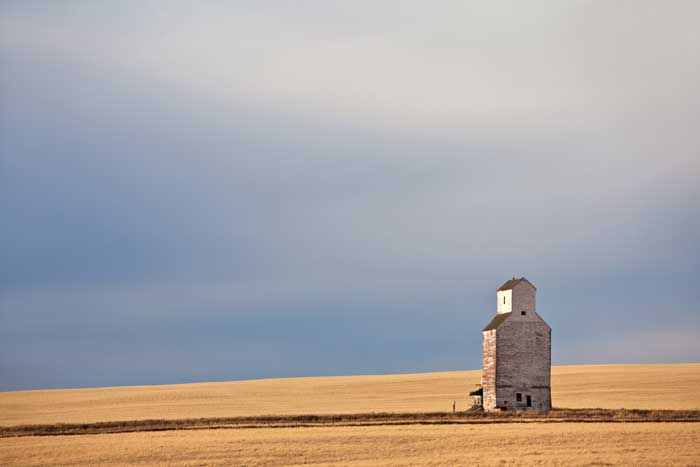A couple of hours before sunset I found “the spot.” The elements were all there. In the foreground golden speargrass and twisted wheat stalks waved in the wicked Chinook wind. The rusty, abandoned rail line could easily be utilized as a leading line to draw the eye into the scene. And, of course, the subject – one of the few wooden grain elevators remaining in southern Alberta – would stand out beautifully against the dark, stormy sky. Of course, time would tell if the light would cooperate and I would get my winning shot.
For wooden grain elevators on the prairie, time hasn’t been so kind. At their peak (in 1934), nearly 1800 of these prairie sentinels peppered the Alberta plains. Every 10 kilometres along the tracks, or so, you’d find an elevator or, due to the large number of grain companies competing for the bounty, perhaps a row of elevators.
In Vulcan, for example, a row of nine grain elevators – famously dubbed “Nine in a Line” – once stood. In hundreds of other prairie towns, “Railway Avenue” was typically home to at least a couple of these wooden “skyscrapers.” Sadly, today the total number of wooden grain elevators remaining in Alberta is down to approximately one hundred.
The very first grain elevator in Alberta was built in 1895 in Strathcona. Following the rapid expansion of the railway system, numerous other wooden grain elevators popped up in the early part of the century. By 1912 nearly 300 elevators had been constructed. From Radway to Rowley, and nearly every town in between, a grain elevator signified our unique brand of prairie prosperity.

The first elevators were smaller and boxier than the “traditional” and commonly used tall designs with a gabled cupola, or pointy peak, that were built en masse starting in the 1920s. Interestingly, the last wooden grain elevators built in Alberta – at Willingdon and Dapp in the mid 1980s – were fairly similar to these early 1920s designs. Why mess with success? (Or the collective pride we prairie folk have with our heritage and architecture.)

The primary purpose of these elevators was for grain storage. Farmers would drive their grain-filled trucks into the unloading bay, drop off their bounty, and the product would be stored in the grain elevator until the company, or the Wheat Board, could sell the grain. It would then be loaded into boxcars and hauled away to the buyers.
The demise of these beautiful and historic structures was due to a number of reasons. For starters, the abandonment of the many rail lines that snaked across the plains led to many of the elevators becoming obsolete. And, no question, the concrete “silo” elevators, now commonly used, provided a much more efficient way of storing and handling the grain. Lastly, the amalgamation of the grain companies also led to a system that was better suited to fewer, larger, and more centrally located terminals.
As such, there are precious few traditional wood grain elevators left to admire and photograph. And, of course, those of us with nostalgic inclinations are drawn to them. In Mossleigh, for example, just forty-five minutes south of Calgary on Highway 23, a row of three classic elevators still stands. And, just a few kilometres south of Mossleigh, a weathered, solitary elevator stands alone in a rolling field; a remnant of the long-gone town of Farrow.

It is here that I saunter along the desolate track and try to capture the prairie’s past. Sure enough, just minutes before sunset, the light breaks beneath the building clouds and the scene comes alive. With my tripod planted on the abandoned tracks, I compose the shot, click the shutter, and record the hauntingly beautiful scene in front of me. The pictures I capture do not speak of promise or prosperity, but rather of a period of time that is fading fast, yet strong in the minds of the many folks – and shutterbugs – who call the prairies home.
(Author’s note: The Farrow grain elevator has recently been destroyed.)
___
Andrew Penner is a Calgary-based writer/photographer. View more of his work at www.andrewpenner.com
